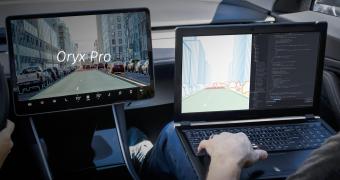Possibly the most amazing thing, to me, about single board computers (SBCs) is that they allow small teams of people (and even lone individuals) to create new gadgets using not much more than SBCs and 3D printers. That opportunity for makers and small companies is absolutely astounding.
Two such projects have really caught my attention lately: the Noodle Pi and the TinyPi.
The Noodle Pi is a simple, handheld computer (about the size of a deck of playing cards). And, when I say simple, I mean simple. It's got a micro-USB charging port, another for plugging in USB devices, a touch screen and a battery. Think of it like an old-school PDA without any buttons (other than a small power toggle) and the ability to run a full Linux-based desktop.

Figure 1. The Credit-Card-Sized, Pi Zero-Powered, Noodle Pi
The TinyPi is a gaming handheld. And, believe it or not, it's even smaller than the Noodle Pi, with a tiny screen and tiny buttons. This is the sort of handheld game console you could put on a keychain.

Figure 2. The Impossibly Small TinyPi (Banana for Scale)
Both of these are built on top of the (super-tiny and super-cheap) Raspberry Pi Zero. And, both are built by lone individuals with a heavy reliance on 3D printers.
I wanted to know how they did it and how their experience was. What can we learn from these independent gadget makers? So, I reached out to both of them and asked them each the same questions (more or less).
Let's start with a chat with Pete Barker (aka "pi0cket"), maker of the TinyPi.
Interview with Pete Barker (pi0cket), TinyPi Maker
Bryan Lunduke: Could you give a quick overview of the TinyPi?
Pete Barker: TinyPi is (unofficially) the world's smallest pi-based gaming device. It started life as a bit of a joke—"how small can i make this?"—but it actually turned into something pretty good. The Pro version added more features and improvements, and a kickstarter was funded on December 30, 2018. Manufacturing is already underway, and the early-bird backers should start getting the kits in February 2019.

Figure 3. The parts of the TinyPi—the Smallest Handheld Game Console I Can Possibly Imagine

 Ubuntu 16.04.6 is a security-fix only release of Ubuntu 16.04 LTS Xenial Xerus. It protects new installs from a APT vulnerability.
Ubuntu 16.04.6 is a security-fix only release of Ubuntu 16.04 LTS Xenial Xerus. It protects new installs from a APT vulnerability. Canonical
Canonical  Canonical released today the Ubuntu 16.04.6 LTS point release to its long-term supported Ubuntu 16.04 LTS (Xenial Xerus) operating system series to address a recently discovered APT vulnerability.
Canonical released today the Ubuntu 16.04.6 LTS point release to its long-term supported Ubuntu 16.04 LTS (Xenial Xerus) operating system series to address a recently discovered APT vulnerability. American computer manufacturer System76 has launched today a refreshed version of its Oryx Pro flagship Linux-powered laptop with latest technologies from Intel and Nvidia, as well as bigger displays.
American computer manufacturer System76 has launched today a refreshed version of its Oryx Pro flagship Linux-powered laptop with latest technologies from Intel and Nvidia, as well as bigger displays.



 The UBports community has put out a call for testing for the next OTA maintenance update for their Ubuntu Touch mobile OS for Ubuntu Phone devices, which will be available next week.
The UBports community has put out a call for testing for the next OTA maintenance update for their Ubuntu Touch mobile OS for Ubuntu Phone devices, which will be available next week. The development team behind the LibreELEC open-source and Linux-based operating system for embedded devices released the first maintenance update in the latest LibreELEC 9.0 "Leia" series.
The development team behind the LibreELEC open-source and Linux-based operating system for embedded devices released the first maintenance update in the latest LibreELEC 9.0 "Leia" series.